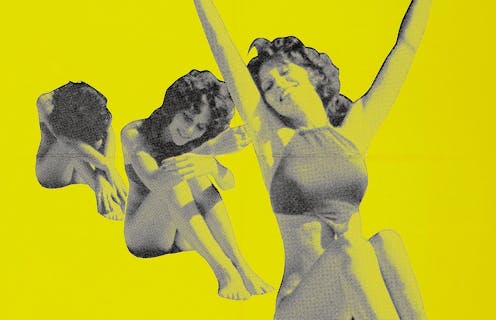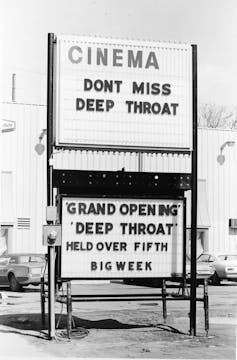Why the re-release of iconic porn film 'Deep Throat' fizzled
The son of the director has argued that Americans are still too squeamish about sex to fully appreciate the film. A porn scholar disagrees.

In 1972, “Deep Throat,” a feature-length porn film directed by Gerard Damiano, was hailed for moving pornography into the mainstream and beginning a golden age of theatrical porn.
To mark the 50th anniversary of its release, a restored high-resolution version was released earlier this year. Yet outside of a few screenings in New York City, most U.S. theaters expressed little interest in showing the film.
As the editor of the essay collection “Pornography: Film and Culture,” I’m not surprised by the relatively muted fanfare to the re-release.
To me, it’s a sign of how much pornography has changed during the past 50 years.
‘Stag’ shorts in ‘smokers’
Film pornography has a long underground history, going back to “stag” shorts in the silent film era, which for decades were screened in “smokers” – named after the all-male audience that gathered to watch the films together and smoke cigars.
In the late 1960s, pornography moved into theaters in porn districts in cities like New York, and these places remained male-dominated settings. The films initially were feature length and while they lacked traditional narratives, many of them had various forms of narrative structure. The 1970 documentary “Sexual Freedom in Denmark,” for example, used educating the public about Denmark’s liberal censorship laws and red light districts as a pretext to screen explicit scenes featuring hardcore sex.
Films such as “He & She,” also released in 1970, featured a young, attractive heterosexual couple. Similarly, this film fashioned itself as instructive in the tradition of marriage manual books but used erotic hardcore pornography to teach the ins and outs of various sexual techniques.
Many other films with now-forgotten titles from the 1970s featured different couples simply having sex. But even those productions often had a loose narrative structure.
The rise of ‘porno chic’
“Deep Throat,” which stars pornographic actress Linda Lovelace, tells the story of a woman whose clitoris is in her throat. Because it was a feature film centered on female sexual pleasure, porn started being seen as somewhat respectable.

When “Deep Throat” premiered in New York in 1972, the response was enthusiastic, giving rise to the term “porno chic.” Movie stars, theater directors and composers embraced the film. Critic Roger Ebert, though he panned the film, called it “the first stag film to see with a date.”
The norm in pornography had been for viewers to simply enter and leave the theater whenever they wished. Starting times were not even listed in newspapers. With “Deep Throat,” however, couples stood in line waiting for the next showing to start. This was, for many couples, their first foray into porn theater districts.
The film is said to have ushered in porn’s golden age, and classics such as “Behind the Green Door” (1972), “The Opening of Misty Beethoven” (1976) and “Barbara Broadcast” (1977) soon followed. These films had comparatively big budgets and told stories with central characters. The production values were high, with good lighting, composition and editing.
The home viewing experience
But by early 1980s, theatrical porn had fallen by the wayside, and home video porn took off.
Homes created comfortable viewing environments for women who felt alienated from – and threatened by – the so-called theater “raincoat crowd” that one female porn film performer described as “isolated men masturbating under their coats.” Now women – and men who were also turned off by the movie theater atmosphere – could watch those same movies from the comfort of their living rooms.
The rise of digital, streaming porn further upended the industry. Feature-length films were replaced by low-budget, comparatively short videos, with no narrative. They often centered on kinks or simple sexual fantasies – feet fetish videos or skimpy narrative premises such as sex between realtors and their clients.
Sometimes longer versions are available for pay, but these often simply feature extended sex scenes rather than plot or character development. Streaming porn on the internet effectively ended the production and exhibition of features. Porn theaters and video stores – where customers could watch porn films in private viewing booths – have become relics of a bygone era.
The re-release lands with a thud
The response to the re-release of “Deep Throat” was so muted that very few people probably even know that 2022 is the 50th anniversary of the film’s initial release. Movie theaters didn’t show it and most of the media didn’t cover it. A high-resolution restored DVD is unavailable, nor is it streaming.
Although he acknowledged today’s appetite for digital porn, the son of director Gerard Damiano, Gerard Jr., seemed to pin the blame on Americans’ puritanical approach to sex.
Americans are “very skittish about talking about anything that has to do with sex,” he told The Guardian. “People today are so afraid of anything sexual because they don’t know what to do… There’s not a lot of sex positivity and we’re hoping to reintroduce that with this film.”
In a separate interview with the New York Post, he noted, “Europe is much more receptive to us. We couldn’t find a U.S. venue that was comfortable showing the film.”
But in my view, saying Americans are skittish about sex doesn’t explain the box office failure of the re-release of “Deep Throat.” The current porn industry was neither built on skittishness nor fear of sex. A quick visit to Pornhub disabuses that notion.
Pornography is a genre much like others with a complex and changing history. It is not one fixed thing: It is not always dangerous, evil trash; nor does watching porn make people sexual perverts or worse. While such serious issues as sex trafficking and sexual abuse have arisen in the porn industry, similar problems have also plagued Hollywood involving high-profile figures such as Kevin Spacey, Harvey Weinstein and Bill Cosby.
With the re-release of “Deep Throat,” the porn industry ultimately may have collided with the #MeToo movement. In her highly publicized memoir, lead actress Linda Lovelace described being physically abused at home while making the film and feeling coerced on the set while shooting the sex scenes.
That aspect of the film’s legacy – more than any sort of squeamishness towards sex – could have also contributed to the reluctance of theaters to screen it.
Peter Lehman does not work for, consult, own shares in or receive funding from any company or organisation that would benefit from this article, and has disclosed no relevant affiliations beyond their academic appointment.
Read These Next
New materials, old physics – the science behind how your winter jacket keeps you warm
Winter jackets may seem simple, but sophisticated engineering allows them to keep body heat locked in,…
West Antarctica’s history of rapid melting foretells sudden shifts in continent’s ‘catastrophic’ geo
A picture of what West Antarctica looked like when its ice sheet melted in the past can offer insight…
How the ‘slayer rule’ might play a role in determining who will inherit wealth from Rob Reiner and h
These rules have a long history in the United States. They played a role in the notorious murders by…






